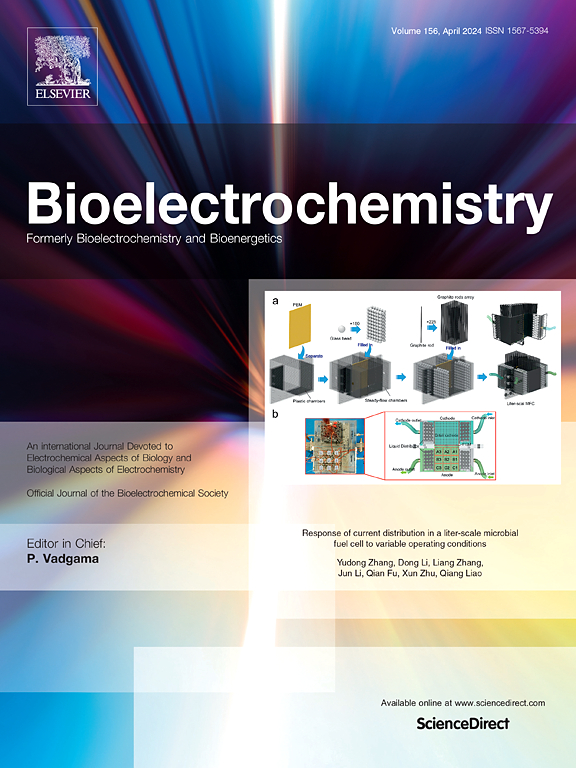A microfluidic co-culture platform for lung cancer cells electrotaxis study under the existence of stromal cells
IF 4.8
2区 化学
Q1 BIOCHEMISTRY & MOLECULAR BIOLOGY
引用次数: 0
Abstract
Tumor metastasis is an important reason for the poor prognosis and high mortality in cancer patients. As major component of stromal cells in tumor microenvironment, cancer-associated fibroblasts (CAFs) secreted various factors to promote tumor metastasis. Studies have indicated that endogenous direct current electric field (dcEF) around tumor tissue induced directional migration of cancer cells. However, the regulatory effect of CAFs on cancer migration under dcEF stimulation is still unknown. In this study, a two-layers polydimethylsiloxane (PDMS)-based microfluidic chip was fabricated. The introduction of concave structures achieved the non-contacted co-culture of different cell types, and parallel channels in the chip provided stable and homogeneous dcEF. Cells electrotactic response was evaluated under co-culture circumstance. The results showed that CAFs exhibited directional migration towards anode under dcEF stimulation, while A549 cells had a trend of directional migration towards cathode. The co-existence of CAFs and dcEF significantly enhanced the motility and cathodal migration of A549 cells, suggesting synergistic influences of chemotaxis from CAFs and electrotaxis from dcEF stimulation. Moreover, we demonstrated that lung normal fibroblasts acquired CAFs properties after stimulated by dcEF, characterizing by increasing gene expression of α-SMA and IL-6. Overall, Our device and study provide new insight for tumor electrotaxis in complex microenvironment.

间质细胞存在下肺癌细胞电趋向性研究的微流控共培养平台
肿瘤转移是导致肿瘤患者预后差、死亡率高的重要原因。癌相关成纤维细胞(cancer-associated fibroblasts, CAFs)作为肿瘤微环境中基质细胞的主要组成部分,分泌多种促进肿瘤转移的因子。研究表明,肿瘤组织周围的内源性直流电场(dcEF)诱导癌细胞定向迁移。然而,在dcEF刺激下,CAFs对肿瘤迁移的调控作用尚不清楚。本研究制备了一种双层聚二甲基硅氧烷(PDMS)微流控芯片。凹形结构的引入实现了不同细胞类型的非接触共培养,芯片内的平行通道提供了稳定均匀的dcEF。在共培养条件下观察细胞的电致反应。结果表明,在dcEF的刺激下,CAFs呈现向阳极定向迁移的趋势,而A549则呈现向阴极定向迁移的趋势。CAFs和dcEF的共存显著增强了A549细胞的运动性和阴极迁移,提示CAFs的趋化性和dcEF刺激的趋电性具有协同作用。此外,我们证实肺正常成纤维细胞在dcEF刺激下获得了cas特性,其特征是α-SMA和IL-6基因表达增加。总之,我们的装置和研究为复杂微环境下的肿瘤电趋向性研究提供了新的思路。
本文章由计算机程序翻译,如有差异,请以英文原文为准。
求助全文
约1分钟内获得全文
求助全文
来源期刊

Bioelectrochemistry
生物-电化学
CiteScore
9.10
自引率
6.00%
发文量
238
审稿时长
38 days
期刊介绍:
An International Journal Devoted to Electrochemical Aspects of Biology and Biological Aspects of Electrochemistry
Bioelectrochemistry is an international journal devoted to electrochemical principles in biology and biological aspects of electrochemistry. It publishes experimental and theoretical papers dealing with the electrochemical aspects of:
• Electrified interfaces (electric double layers, adsorption, electron transfer, protein electrochemistry, basic principles of biosensors, biosensor interfaces and bio-nanosensor design and construction.
• Electric and magnetic field effects (field-dependent processes, field interactions with molecules, intramolecular field effects, sensory systems for electric and magnetic fields, molecular and cellular mechanisms)
• Bioenergetics and signal transduction (energy conversion, photosynthetic and visual membranes)
• Biomembranes and model membranes (thermodynamics and mechanics, membrane transport, electroporation, fusion and insertion)
• Electrochemical applications in medicine and biotechnology (drug delivery and gene transfer to cells and tissues, iontophoresis, skin electroporation, injury and repair).
• Organization and use of arrays in-vitro and in-vivo, including as part of feedback control.
• Electrochemical interrogation of biofilms as generated by microorganisms and tissue reaction associated with medical implants.
文献相关原料
公司名称
产品信息
索莱宝
Fibronectin
 求助内容:
求助内容: 应助结果提醒方式:
应助结果提醒方式:


